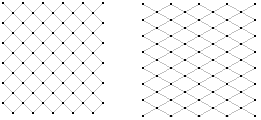


This is a beginner's pattern for Bucks Point. It is very similar to the Torchon fans headside, so the differences high-light how the two styles differ.
Pattern:

Bobbins: 9 pairs
Style: Bucks Point
Stitches:
half stitch and twist
twist
cloth stitch and twist
cloth stitch
Details:
Bucks Point net (grey)
cloth footside (grey)
cloth stitch fans (red)
Description:
Click here for how to do a cloth footside, which includes an animation, that you can repeat, or step through.
Click here for how to do a Bucks Point net, which includes an animation, that you can repeat, or step through. 'Net' is the Bucks Point term for ground. Bucks Point net "muddles up the bobbins", that is, pairs do not stay together. This is something that you just have to get used to if you work this style of lace! Bucks Point net can be C T T, or C T T T, or even C T T T T. I prefer C T T T, as it gives a stronger result, and is easier to tighten.

The fans look different to the Torchon fans, because the two styles of lace are designed on fundamentally different grids - see above. The Torchon lace grid, on the left, has the lines at 45°, while the Bucks Point grid, on the right, has the lines at 60°. This means that in Torchon, you tend to see squares, while in Bucks Point, you tend to see hexagons. However, surprisingly enough, there is no difference in how you work the lace. There are still rows of cloth stitch, and diagonals of ground (or net), and the footsides are almost the same. The differences in working are the choice of one type of stitch over another, and this is nothing to do with the grid. But the grid alters the appearance of the result a lot.
The cloth footside used here seems to be the preferred footside for Bucks Point. It does require 4 pairs of bobbins (2 passives, the edge pair, and the pair coming in from the lace), compared with a single twisted footside, which requires 3 pairs, and the single twisted Winkie Pin footside, 2 pairs, or the gimp footside, which only needs a single pair and a gimp thread. If you want a "proper" Bucks Point, then use cloth footside, but the others are a possibility.

Close up of the lace, so you can see the working in more detail
© Jo Edkins 2016 - return to lace index